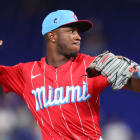Last season, Jed Lowrie made the All-Star team for the first time. He launched 23 homers, knocked in 99 runs, and ranked among the league leaders in every offensive category at his position. That position, other than a little fill-in work at third and DH, was second base.
So when the Mets courted Lowrie as a free agent this offseason, they made him an offer he couldn't refuse. He wouldn't be the everyday second baseman. He wouldn't be the everyday third baseman. With newly acquired Robinson Cano along with young shortstop Amed Rosario, veteran third baseman Todd Frazier, first baseman and hot-shot prospect Peter Alonso, and others in the fold, Lowrie wouldn't have an everyday starting job at any position.
New Mets GM Brodie Van Wagenen assured Lowrie that despite being given that rover role, the veteran infielder would get enough reps all over the diamond to play nearly everyday. Lowrie was totally OK with this.
"If you look at look at a lot of teams that have had recent success, they're very deep, and I think that's what it takes to win at the major league level at this point," Lowrie told the Associated Press last week, after signing a two-year, $20 million deal to be every Mets infielder's backup.
Despite being an excellent player, Lowrie is 34 years old, and the current free-agent market is a disaster for players as teams work to tamp down salaries. So you can maybe understand why he'd accept a superutility role.
But what about D.J. LeMahieu? The former Rockie is a two-time All-Star and also just 30 years old. Unlike Lowrie, who played other positions fairly frequently before last season, LeMahieu has spent the vast majority of his major league playing time at second, logging 892 of his 941 games there. He's also won three Gold Gloves at second base, leading you to figure that multiple teams would line up to sign him and start him at the deuce.
The Yankees wanted no such arrangement. With Gleyber Torres the likely starter at second, plus Miguel Andujar and Troy Tulowitzki on board, Didi Gregorius likely to return from injury next summer, and maybe even a last-minute play for Manny Machado a possibility, LeMahieu wouldn't be the everyday second baseman. Instead, he would instead play multiple positions as needed, but with no regular gig anywhere.
The Yankees offered LeMahieu a two-year, $24 million contract to play this role. And he accepted.
"I was told to bring a lot of gloves, if that's any indication," LeMahieu told reporters.
Welcome to the Zobristification of baseball. Long gone are the days when iron-man streaks are worth celebrating. Say goodbye to set roles for players across the diamond. Instead, major league teams are looking under every rock for jacks-of-many-trades who can subsume their egos, play multiple positions, and keep everyone rested. And like Ben Zobrist did for the underdog Rays and the curse-busting Cubs, hopefully pave the way for a fresh roster come October.
Research by CBS Sports sleuth deluxe John Fisher bears out this trend. Fisher went back 50 years to see how many players played 100 innings or more at three or more different positions (excluding DH).
- From 1969 through 1980, an average of 15.7 players filled that role per season.
- From 1981 through 1985 (counting the strike-shortened '81 season), an average of just 10 players did so.
- From 1986 through 1993, 15.4 players played 100 or more innings at three or more positions.
- From 1994 to 1999 (counting the strike-shortened 1994 and 1995 seasons), 12.3 players did it.
Starting in 2000, the trend began to change. Here's a rundown of the 2000-2015 seasons, with our man Zobrist leading the way for much of that time.
| Year | Players with 100+ innings at 3+ positions |
|---|---|
2000 | 21 |
2001 | 20 |
2002 | 22 |
2003 | 18 |
2004 | 23 |
2005 | 26 |
2006 | 22 |
2007 | 19 |
2008 | 17 |
2009 | 23 |
2010 | 21 |
2011 | 24 |
2012 | 18 |
2013 | 22 |
2014 | 22 |
2015 | 18 |
That's an average of 21 players per season, a notable uptick when compared to other seasons in the era since MLB expanded to four (and later more) divisions.
It's over the past three seasons, however, when the trend truly takes flight:
| Year | Players with 100+ innings at 3+ positions |
|---|---|
2016 | 28 |
2017 | 29 |
2018 | 29 |
If Zobrist was the avatar for the superutility role in the past, Marwin Gonzalez might be its poster boy in today's game. The Venezuela-born Swiss army knife broke into the majors in 2012, playing 47 games at short, 14 at third base, and six at second base. He was still primarily a shortstop in 2013, logging 53 games there, 10 at second, and four at third.
It took until 2014 before the full scope of his do-it-all skillset emerged. That season, Gonzalez played six different positions, still seeing the most time at short, but also punching the clock at first, second, third, in left, and in right (while also serving three games as the team's DH). The following year he played five positions (everywhere but catcher, center, and right), with first base becoming his most frequent role. In 2016 he again saw more action at first than anywhere else, playing everywhere except catcher and right field.
In 2017 he shifted his primary role to left field, but spread himself absolutely everywhere: 47 games in left, 38 at short, 31 at first, 22 at second, 19 at third, and two in right. That was also the season that Gonzalez became a minor star, and a driving force behind the Astros' success, batting a huge .303/.377/.530 as Houston surged to its first-ever World Series title. A look at advanced stats from that year (such as Expected Weighted On-Base Average) tell us that Gonzalez's numbers were probably a bit flukish that year, with regression knocking his stats back to career norms in 2018. Still, even if Gonzalez profiles as more of a league-average hitter, he's one of the most sought-after commodities left on this year's free-agent market, thanks to his supreme versatility.
While the past three years' of three-position data tell us that priorities have changed in baseball, keep an eye on the next batch of prospects to hit the big leagues. Will we see more Zobrists and Marwins break onto the scene, pairing capable bats with both an ability and willingness to play everywhere on the diamond? Better yet, could we see some of the top prospects in the game try their hand in multiple spots? Though baseball's old school of thought is to give young players ample reps at one position to get comfortable (and to not distract them from developing offensively), you have to wonder what, say, Vladimir Guerrero Jr. could do if he's both raking, and playing both infield corner positions.
As for the rest of this winter's free agents, stay tuned. Matt Davidson's already decided to take up pitching, joining a growing trend of two-way players taking the concept of versatility to extremes. If third baseman Mike Moustakas shows up to spring training lugging a catcher's mitt, or shortstop Freddy Galvis adds advance scout and popcorn vendor to his resume, we'll know that the revolution has truly arrived.


















